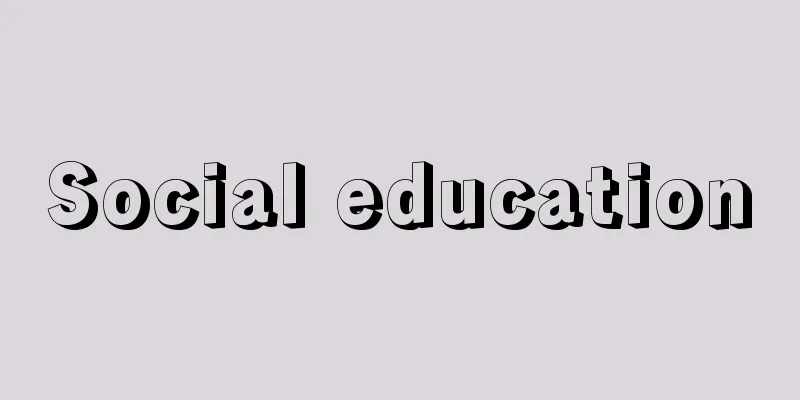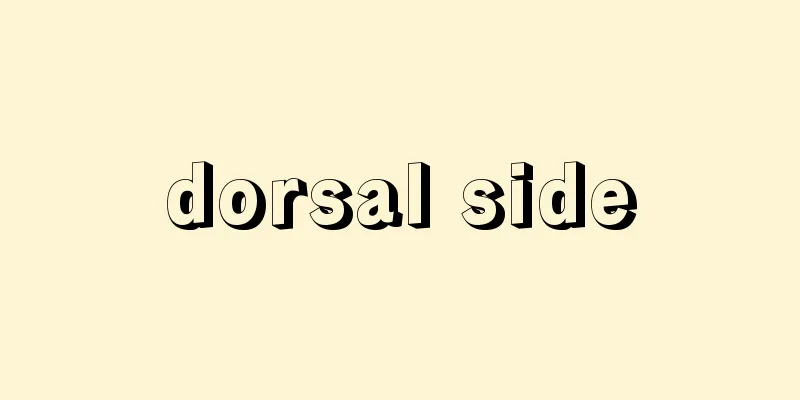Social education

|
Educational activities carried out in society outside of school education. The term "social education" is a uniquely Japanese concept that has been in use since the Meiji period, when Yamana Jiro (1864-1957) wrote "Social Education Theory" in 1892 (Meiji 25). It was used in a similar way to the English term "social education," meaning education that cultivates sociability, as in education that forms people who are socially conscious, but it usually meant education that takes place within society, as opposed to school education. The school system in the Meiji period was modeled on the Western model, and there was a large gap between it and society, which is thought to be the background to the establishment of this concept. This also included unintentional human development. [Uesugi Takazane] JapanFrom the Meiji to Taisho periods, the most common official term for "social education" was "popular education," which is thought to be a translation of the French term "éducation populaire." It is said that the word "society" was avoided because it was reminiscent of socialism. Nevertheless, "social education" continued to be used, and in 1921 (Taisho 10), the Ministry of Education also adopted it as an official term. At that time, it often meant group activities and lifestyle improvement movements more than lectures or classes, and after 1937 (Showa 12), it became more strongly characterized as playing a part in the national spiritual mobilization movement promoted by the government. Initially, "social education," which meant influence within society, was thought of as being the same as social education, but gradually "education" came to be seen as indoctrination. The Social Education Law enacted in 1949 (Showa 24) defined social education as "in this Law" and said, "Based on the School Education Law (Law No. 26 of 1947), social education refers to organized educational activities (including physical education and recreational activities) conducted primarily for young people and adults, excluding educational activities conducted as part of the school curriculum." This limited the concept to intentional educational activities. Before the Second World War, social education facilities were scarce and group-based social education was seen, but after the war, the importance of facilities was emphasized, efforts were made to popularize community centers, and the Library Law and Museum Law were also enacted, and social education gradually developed. Although many groups were government-run before the war, the Social Education Law stipulated that social education-related groups were not under public control, and social education officers were prohibited from issuing orders or supervision. In connection with democratization and the New Life Movement, the opening of social studies classes and courses in schools was encouraged, and many classes and courses such as youth classes and women's classes began to be held in various places, based at community centers. In 1954, the Japan Youth Association proposed a form of collaborative learning in which people jointly research, discuss, and seek solutions to problems in their daily lives, and it began to spread primarily through classes. From the 1960s onwards, with rapid economic growth, issues such as the demolition of communities and pollution became problems, and learning to address these issues became more popular, and the importance of systematic and scientific learning also came to be pointed out. The idea of lifelong learning, proposed by UNESCO (United Nations Educational, Scientific and Cultural Organization) in 1965, had a major impact on social education in Japan, emphasizing the cooperation and integration of school education and social education, and encouraging the opening of universities to the public. In addition, the involvement of not only the Board of Education but also the head of the local government was strengthened. Since the third report of the Provisional Council on Education in 1987 called for a "transition to a lifelong learning society," a movement to include social education in lifelong learning has become noticeable since then. The "Act for the Promotion of Specified Nonprofit Activities" (NPO Act), enacted in 1998, makes it easier for nonprofit organizations (NPOs) to obtain legal status when carrying out specified nonprofit activities, and "activities to promote social education" and "activities to promote culture, arts, or sports" are included in the specified activities. Attention is focused on how social education activities in the private sector will develop along with public social education. In social education, emphasis is placed on learning about life issues, and the ideal is to develop the self-reliance of residents in relation to resident autonomy, and its distinctive feature is the development of mutual education that includes not only adults but also young people. The combination of learning and practice, which is also connected to community building, has also been emphasized. Literacy education, which has been developed together with social harmony education to eliminate discrimination, must be promoted in combination with all kinds of learning that supports life as basic education for adults. Improving human rights education is also an issue in order to realize gender equality and a society in which multiple cultures and ethnicities coexist. [Uesugi Takazane] foreign countryIn the West, there is no concept that corresponds to Japanese social education. Adult education and youth work are close to this, but the former does not necessarily exclude school education, and the latter has been developed as a social work rather than education. In England, adult education includes literacy education to teach the people the ability to read the Bible as part of religious activities, which became popular after the 18th century, and science and culture club activities at coffee houses. In the 19th century, the number of schools for adults increased, and in the latter half of the century, university professors went to the countryside to provide organized adult education. This was called university extension, and the movement to open universities became stronger. In the early 20th century, the Workers' Education Association (WEA) was also founded, and it has been working to spread liberal arts education to workers through collaboration with universities. Since the 1920s, universities have established off-campus education departments, and the allocation of full-time adult education teachers has progressed. The principle of public libraries being free was established in the Public Libraries Act of 1850, which aimed to establish public libraries in cities. Adult education by local education authorities has expanded with the development of further education colleges and adult education centers that developed from night schools after the Education Act of 1944. Youth activities are notable for private movements such as the YMCA and YWCA, which were established in the 19th century, and the Boy Scouts and Girl Guides (Girl Scouts), which began in the early 20th century. In the 1960s, however, emphasis was placed on youth services (youth work), with the establishment of youth clubs and the placement of youth workers. From the 1970s, community education, which focuses on people who do not participate in school-based adult education and tackles local issues, also became active, and efforts were made to integrate it with youth work. In Scotland, in particular, policies were adopted to integrate all educational activities under this concept. On the other hand, due to the influence of policies that emphasize the economy, adult education, centered on professional and vocational education, increased in universities, and many universities changed their adult education departments, which were successors to off-campus education departments, into further education departments or further education centers. As a result of the Education Reform Act of 1988 and the Further and Higher Education Act of 1992, further education colleges have been taken away from local education authorities and are now independent, but the central government's influence through funding is increasing. In the Nordic countries, residential type people's universities, Folke-Højskole (also called Folkehschule, Folkehuniversity or Citizens' University), founded in Denmark in the mid-19th century, are widespread, while in Sweden, publicly subsidized study circles are well known. In Germany and Austria, people's universities, Volkshochschule, are also well developed, although most are not residential. In France, many private associations have been carrying out adult education activities with public assistance since the beginning of the 20th century. In the United States, state universities were established around the beginning of the 19th century, and adult education was promoted with a view to developing local industries. Private universities also established extension departments and promoted university openness programs. Since the 20th century, junior colleges have played a major role in adult education as community colleges where anyone in the local area can study. Adult education through university expansion is commonly seen in Canada and other Commonwealth countries. Within Asia, the concept of social education exists in South Korea and Taiwan, while in Southeast Asian countries such as Indonesia, efforts are being made to promote education outside of school under the name of non-formal education. [Uesugi Takazane] "Studies on the History of Social Education in Modern Japan" by Miyasaka Hirosaku (1968, Kokudosha) ▽ "A Centennial History of Education in Modern Japan" 7-8 (1974, National Institute for Educational Research) edited by National Institute for Educational Research ▽ "Theory of Modern Social Education" edited by Ogawa Toshio (1977, Akishobo) ▽ "History of the Development of Social Education in Europe and the United States" edited by Kobori Tsutomu (1978, Akishobo) ▽ "Revised Outline of Social Education" edited by Nagasugi Kisuke and Fujiwara Hideo (1981, Kyodo Publishing) ▽ "International Trends in Social Education" edited by the Japan Society for the Study of Social Education (1987, Toyokan Publishing) ▽ "The Creation of Social Education" edited by the Japan Society for the Study of Social Education (1988, Toyokan Publishing) ▽ "The Development of Community Education" by Uesugi Takazane (1993, Shoraisha) ▽ "Toshiro Ogawa, Toshiro Ogawa's Social Education Theory Collection, 8 volumes (1992-2001, Akishobo)" [References] | | | |Community | | | | | | | | |Source: Shogakukan Encyclopedia Nipponica About Encyclopedia Nipponica Information | Legend |
|
学校教育以外の社会において行われる教育活動。「社会教育」という語は、日本独特の概念で明治期から使われ、1892年(明治25)には、山名次郎(1864―1957)が『社会教育論』を著している。社会を意識した人間を形成する教育のように、社会性を養う教育という意味の英語、social educationに近い用法もみられたが、通常は学校教育に対して、社会のなかで行われる教育を意味した。明治期における学校制度が欧米をモデルにしていて、社会とのずれが大きかったことが、この概念の成立の背景にあると考えられる。ここには、意図的でない人間形成作用も含まれていた。 [上杉孝實] 日本における展開明治から大正にかけて、「社会教育」に近い官庁用語としては、フランス語のéducation populaireの訳語と思われる「通俗教育」がよく用いられた。「社会」ということばが、社会主義を連想させるので忌避されたといわれている。それでも「社会教育」は使われ続け、1921年(大正10)には文部省も公用語として採用するようになる。このころは、講座・学級以上に団体活動や生活改善運動を意味することが多く、37年(昭和12)以後は政府の進める国民精神総動員運動の一翼を担うものとしての性格が濃くなっていく。当初、社会のなかでの影響を意味した「社会教化」も、社会教育と重ねて考えられていたが、しだいに「教化」は教え込みとして受け止められるようになる。 1949年(昭和24)成立の社会教育法では、「この法律で」と定義し、社会教育は「学校教育法(昭和22年法律第26号)に基き、学校の教育課程として行われる教育活動を除き、主として青少年及び成人に対して行われる組織的な教育活動(体育及びレクリエーションの活動を含む。)をいう。」とされ、意図的な教育活動に限定した概念規定が示された。第二次世界大戦前には社会教育施設が乏しく、団体中心の社会教育がみられたが、戦後は施設の重要性が強調され、公民館の普及が図られ、図書館法や博物館法もつくられて、しだいに発展を示すようになった。戦前は官製のものが多かった団体についても、社会教育法は、社会教育関係団体は公の支配に属しないものと規定し、社会教育主事についても命令・監督をすることが禁止された。 民主化や新生活運動との関連で、学校における社会学級や講座の開設が促され、公民館などを拠点に各地で青年学級、婦人学級など学級・講座が多く開かれるようになる。1954年、生活課題について、共同で調べ、話し合い、解決の方向を探る共同学習が、日本青年団協議会によって提唱され、学級を中心に広がりをみせるようになる。60年代以後高度経済成長に伴って、地域の解体や公害が問題になり、これらに取り組む学習も盛んになり、体系的・科学的な学習の重要性も指摘されるようになる。 1965年に、ユネスコ(国連教育科学文化機関)で提起された生涯教育の考えは、日本の社会教育にも大きな影響を与え、学校教育と社会教育の連携や結合が強調され、大学開放も促された。また、教育委員会のみならず、首長部局のかかわりが強められる。87年の臨時教育審議会(臨教審)の第三次答申が「生涯学習社会への移行」を打ち出したこともあって、このころから生涯学習に社会教育を包摂するような動きも目だつようになる。98年(平成10)成立の「特定非営利活動促進法」(NPO法)は、非営利団体(NPO)が特定非営利活動を行うにあたって法人格をとりやすくするもので、「社会教育の推進を図る活動」や「文化、芸術又はスポーツの振興を図る活動」なども、その特定活動に含まれている。公的社会教育とともに民間の社会教育活動がどのように発展するかが注目されている。 社会教育では、生活課題学習が重視され、住民自治との関連で住民の主体形成が理念とされて、成人のみならず青少年も含めて相互教育の展開にその特性がみいだされている。地域づくりともつながる、学習と実践の結合も強調されてきた。差別をなくすための社会同和教育とともに展開されてきた識字教育は、成人基礎教育として生活を支えるあらゆる学習と結合して推進されなければならない。男女平等や多文化・多民族共生社会の実現に向けて、人権教育の充実も課題となっている。 [上杉孝實] 外国欧米では、日本の社会教育に一致する概念はない。成人教育やユース・ワークyouth work(青少年事業)がほぼこれに近いが、前者はかならずしも学校教育を排除する概念ではないし、後者は教育としてよりも社会事業として展開されてきた。イギリスでの成人教育としては、18世紀以後盛んになった、宗教活動の一環として民衆に聖書を読む力をつけるための識字教育や、コーヒーハウスでの科学・文化クラブ活動がある。19世紀には、成人のための学校も増え、後半からは大学人が地方に出かけて組織的に成人教育を行うようになり、大学拡張university extensionとよばれ、以後大学開放の動きが強まる。20世紀初頭には労働者教育協会(WEA)も設立されて、大学との連携などによって、労働者への教養教育の普及が図られてきた。1920年代以後大学に構外教育部が設けられるようになり、成人教育専任の教員の配置が進む。なお都市に公共図書館の設置を図る1850年の公共図書館法で、公立図書館無料の原則が確立した。 1944年の教育法以後発達してきた継続教育カレッジや、夜間学校などから発展した成人教育センターなどによって、地方教育当局のかかわる成人教育も広がってくる。青少年活動としては、19世紀に結成されたYMCAやYWCA、20世紀初頭に始まったボーイスカウトやガールガイド(ガールスカウト)のように、民間運動が目につくが、60年代には、ユース・サービス(ユース・ワーク)にも力が入れられ、ユース・クラブの設置やユース・ワーカーの配置が進んだ。70年代からは、学校型の成人教育に参加しない人々に目を向けて地域での課題に取り組むコミュニティ教育も活気を呈し、ユース・ワークとの統合も図られ、とくにスコットランドでは、この概念のもとに、あらゆる教育活動を統合する政策がとられるようになる。一方、経済重視の政策の影響もあって、大学では専門職業教育を中心とした成人教育も増大し、構外教育部の流れを受け継ぐ成人教育部が継続教育部や継続教育センターに変わるところが増えてくる。88年の教育改革法や92年の継続教育・高等教育法によって、継続教育カレッジは地方教育当局の手を離れ、独立的地位にあるが、資金を通じて中央政府の影響力が強まっている。 北欧諸国では、19世紀なかばにデンマークで創設された宿泊型の民衆大学Folke-Højskole(国民高等学校、国民大学、市民大学などともよばれる)が普及し、このほか、スウェーデンでは、公的補助を受けるスタディ・サークルの活動が有名である。ドイツやオーストリアでも、多くは非宿泊型であるが、民衆大学Volkshochschuleが発達している。フランスでは、20世紀初めから、多くの民間団体のアソシアシオン(アソシエーション)が、公的援助も受けながら成人教育活動を展開している。 アメリカでは、19世紀に入るころから、州立大学が設置され、地域の産業振興という観点から成人教育が促進される。私立大学でも、拡張部を設けて、大学開放事業を推進している。20世紀以後、短期大学は、地域のだれもが学ぶことのできるコミュニティ・カレッジとして、成人教育にも大きな役割を演じている。大学拡張による成人教育は、カナダなどイギリス連邦諸国によくみられるものである。 アジアのなかでも、韓国や台湾では、社会教育の概念が存在するが、インドネシアなど東南アジア諸国では、ノン・フォーマル教育の名称のもとで、学校外教育の振興が図られている。 [上杉孝實] 『宮坂広作著『近代日本社会教育史の研究』(1968・国土社)』▽『国立教育研究所編『近代日本教育百年史』7~8(1974・国立教育研究所)』▽『小川利夫編『現代社会教育の理論』(1977・亜紀書房)』▽『小堀勉編『欧米社会教育発達史』(1978・亜紀書房)』▽『永杉喜輔・藤原英夫編『改訂社会教育概説』(1981・協同出版)』▽『日本社会教育学会編『社会教育の国際的動向』(1987・東洋館出版社)』▽『日本社会教育学会編『社会教育の創造』(1988・東洋館出版社)』▽『上杉孝實著『地域社会教育の展開』(1993・松籟社)』▽『小川利夫著『小川利夫社会教育論集』全8巻(1992~2001・亜紀書房)』 [参照項目] | | | | | | | | | | | | |出典 小学館 日本大百科全書(ニッポニカ)日本大百科全書(ニッポニカ)について 情報 | 凡例 |
>>: Social relations (English spelling) soziale Beziehung German
Recommend
Azumino Hirafu - Azumino Hirafu
Date of birth and death unknown. A diplomat and g...
Dollfuss, Engelbert
Born: October 4, 1892, Tecsing [Died] July 25, 193...
Kakichi
...The political and cultural center of those day...
Veratrum maackii (English spelling) Veratrummaackii
…[Tetsuichi Yahara]. … *Some of the terminology t...
Calc - Light
…It is a corrupted word of the Dutch word kalk an...
motion study
…He became an apprentice to the Building Engineer...
Alkaline manganese storage battery - Alkaline manganese storage battery
...Silver oxide-zinc batteries were first develop...
Echo (English spelling)
In Greek mythology, she is an echo-female spirit. ...
Daniel Cosío Villegas
1898‐1976 Mexican intellectual and historian. He p...
Hidden Head/Exit - Onshu Kasshutsu
A term used in ancient Japanese ritsuryo. When a p...
tavul
...Drums of Western Asia. In Iran, they are calle...
Bai (locust) - Bai (English spelling) Babylonia japonica
A gastropod shell of the Bucconidae family (illust...
Glass wool
…Made of molten glass in a filament, it is also c...
INF problem
...The construction of a new order has begun, inc...
Imperial mourning - Kyūchūmo
Mourning was held at the Imperial Palace when the ...









